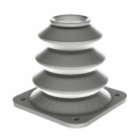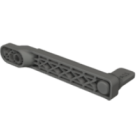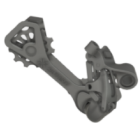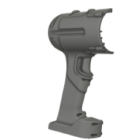Filament types for 3D printing
Choosing the right filament is one of the most important decisions in any FDM 3D printing workflow. It directly affects part strength, flexibility, appearance, durability, and even printer compatibility. From basic prototyping to functional parts and demanding industrial applications, each filament type serves a unique purpose — and knowing the differences will help you get better results, every time.
What is 3D printer filament made of?
Most 3D printer filaments are thermoplastics — materials that soften when heated and solidify when cooled, allowing them to be extruded layer by layer. These polymers vary in chemical composition, performance characteristics, and intended use. Some include added fibers, colors, or impact modifiers to enhance specific properties like stiffness, UV resistance, or visual texture.
Common filament materials and their applications
PLA (Polylactic Acid)
A popular entry-level filament, PLA is easy to print, biodegradable, and perfect for prototypes, models, and non-functional parts. It prints at low temperatures, doesn’t warp much, and is available in a wide color range — but it’s brittle and has low heat resistance.
ABS (Acrylonitrile Butadiene Styrene)
More durable than PLA, ABS is known for its strength and impact resistance. It requires a heated bed and controlled printing environment due to warping but is great for mechanical components and enclosures.
PETG (Polyethylene Terephthalate Glycol)
PETG blends ease of use with good mechanical strength and chemical resistance. It’s less brittle than PLA and more stable than ABS, making it a go-to for functional parts like brackets, containers, and mechanical assemblies.
TPU / TPE (flexible filaments)
These elastomeric filaments are used for soft-touch or flexible applications such as gaskets, wearable components, and protective cases. TPU offers excellent durability and flexibility, but requires slower print speeds and precise retraction settings.
Nylon (polyamide)
Strong, impact-resistant, and slightly flexible, nylon is ideal for functional parts under stress. It can absorb moisture quickly, so storage and drying are critical. Great for gears, hinges, and dynamic components.
Carbon Fiber-infused filaments
These are usually based on PLA, PETG, or Nylon blended with chopped carbon fibers. They’re stronger, more dimensionally stable, and stiffer — ideal for structural parts, drone components, and jigs.
Comparative table: popular filament types for 3D printing
| Filament | Ease of use | Strength | Flexibility | Heat resistance | Surface finish | Key applications |
|---|---|---|---|---|---|---|
| PLA | ★★★★★ | ★★☆☆☆ | ★☆☆☆☆ | ★★☆☆☆ | ★★★★☆ | Visual prototypes, concept models, education |
| ABS | ★★★☆☆ | ★★★★☆ | ★★☆☆☆ | ★★★★☆ | ★★☆☆☆ | Functional enclosures, brackets, automotive parts |
| PETG | ★★★★☆ | ★★★★☆ | ★★☆☆☆ | ★★★☆☆ | ★★★☆☆ | Mechanical parts, containers, tools |
| TPU / TPE | ★★☆☆☆ | ★★★☆☆ | ★★★★★ | ★★★☆☆ | ★★★☆☆ | Flexible components, phone cases, seals |
| Nylon (PA) | ★★☆☆☆ | ★★★★★ | ★★★☆☆ | ★★★★☆ | ★★★☆☆ | Gears, hinges, wear-resistant prototypes |
| CF composites | ★★★☆☆ | ★★★★★ | ★★☆☆☆ | ★★★★☆ | ★★★☆☆ | Drone frames, functional tooling, structural parts |
| PC, PEEK, PEI | ★☆☆☆☆ | ★★★★★ | ★★☆☆☆ | ★★★★★ | ★★☆☆☆ | Aerospace, high-temp engineering, healthcare |
Specialty and engineering filaments
For industrial-grade applications, filaments like Polycarbonate (PC), PEEK, and Ultem (PEI) offer high strength, heat resistance, and flame retardance — but they require high-temperature printers with enclosed chambers.
Conductive, glow-in-the-dark, wood-filled, and metal-infused filaments are also available, mostly for prototyping or visual effect rather than performance.
Filament compatibility: is it universal?
Not all filaments work with every printer. Key considerations include:
- nozzle temperature range – some filaments (like PLA) need ~200°C, while PC or PEEK can require 300°C+,
- heated bed requirements – materials like ABS and Nylon need a heated bed to prevent warping,
- extruder type – flexible filaments print best with direct drive systems.
Always check your printer’s specifications and ensure it’s compatible with the filament’s requirements.
Do 3D printers come with filament?
Some desktop 3D printers include a small sample spool of PLA, but it’s usually limited to a few prints. For serious projects, you’ll need to purchase additional filament. The good news is that filament is widely available both online and through specialty suppliers, often in 1.75 mm or 2.85 mm diameters depending on the printer model.
How much filament do you need?
The amount of filament used depends on the size, density, and infill of the model. Most spools come in 500g or 1kg sizes, which can last for many prints if your objects are hollow or low-volume. For large or solid parts, it’s easy to go through a full spool in a few sessions.
Slicing software gives you an exact estimate of filament usage (in grams or meters) before you print, helping avoid waste or mid-print runouts.
Which filament is best for 3D printing?
There’s no universal answer — it depends entirely on your application. For visual models or education, PLA is hard to beat. For engineering-grade strength, PETG or carbon-filled nylon are top choices. For durability and impact, ABS and TPU are solid performers. And if you’re entering high-performance territory, PC, PEEK, or Ultem are the benchmark.
Summary
Understanding filament types for 3D printing isn’t just about choosing color or price — it’s about optimizing your entire process. The right material improves part quality, saves time on rework, and ensures that your printed components are fit for purpose. As filament technology advances, so too does what’s possible with desktop and industrial FDM printing — making it more powerful, flexible, and application-driven than ever before.
Explore also
- Polymers in 3D printing
- 3D printing of metals
- Biocompatible materials for 3D printing
- Raw materials for 3D printing
- Composites 3D printing
- Recycled 3D printing filament
- 3D printing flexible
Related categories













